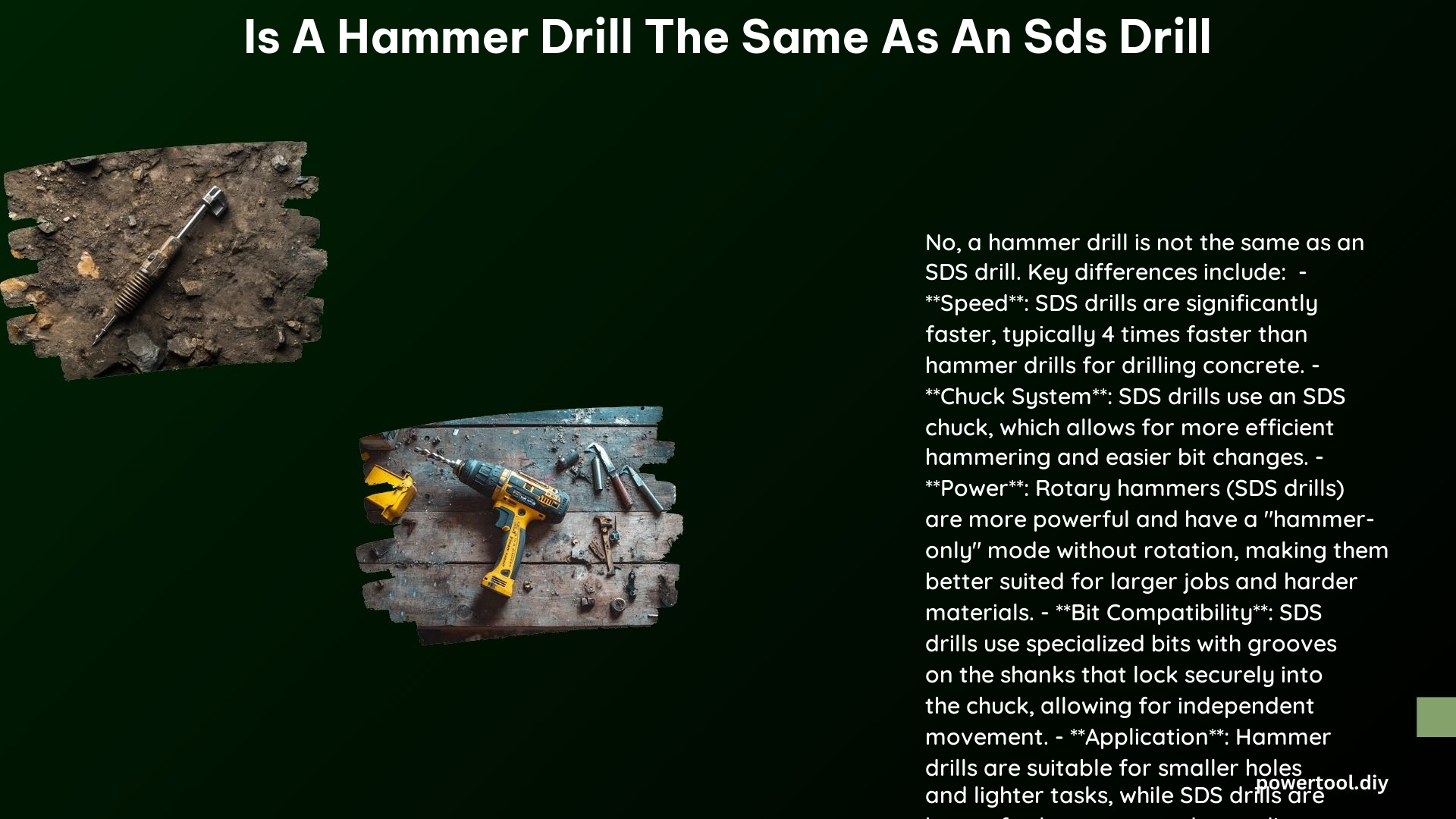No, a hammer drill and an SDS drill are not the same. While both are designed for drilling into masonry materials like concrete and brick, they differ in their mechanism, power, and application. Let’s dive deeper into the key differences between these two types of drills.
Mechanism
Hammer Drill:
– A hammer drill uses a mechanical hammering action to drill into masonry.
– It has two discs with ridges that slide past each other, causing the chuck to slam forward and back, creating a pounding force.
– The hammering action is generated by the internal mechanism of the drill, which is typically less powerful than an SDS drill.
SDS Drill:
– An SDS drill uses a more powerful hammering action, typically with a “hammer-only” mode without rotation.
– It often features an SDS chuck, which allows for more efficient hammering and better bit retention.
– The SDS chuck design enables the drill bit to move back and forth freely, maximizing the impact force and reducing the strain on the user’s wrist.
Power

Hammer Drill:
– Hammer drills are generally less powerful than SDS drills and are suitable for smaller tasks, such as drilling a few holes for tapcons.
– The average power output of a hammer drill ranges from 500 to 800 watts.
SDS Drill:
– SDS drills are more powerful and designed for larger, more demanding tasks, such as drilling multiple large holes in hardened concrete.
– The power output of an SDS drill typically ranges from 800 to 1,200 watts, with some high-end models reaching up to 1,500 watts.
Application
Hammer Drill:
– Hammer drills are suitable for smaller masonry projects, such as installing a few tapcons or drilling small holes in cinderblock.
– They are often used for light-duty tasks like drilling into brick, mortar, or soft concrete.
SDS Drill:
– SDS drills are better suited for larger masonry projects, such as drilling multiple large holes in concrete or for heavy-duty applications like breaking up concrete or removing tile.
– They are designed to handle more demanding tasks that require higher power and impact force.
When to Choose an SDS Drill
Large-scale projects:
– If you need to drill multiple large holes in hardened concrete or perform heavy-duty tasks, an SDS drill is the better choice.
– SDS drills can handle larger diameter bits, typically ranging from 1/2 inch to 1 inch, making them suitable for larger-scale projects.
Speed and efficiency:
– If speed is a critical factor, an SDS drill can significantly reduce drilling time compared to a hammer drill.
– The powerful hammering action and efficient bit retention of an SDS drill allow for faster drilling in masonry materials.
Heavy-duty applications:
– SDS drills are designed for tasks that require more power and control, such as breaking up concrete or removing tile.
– They can generate up to 4,500 impacts per minute, making them ideal for heavy-duty applications.
Technical Specifications
SDS-Plus Chuck:
– The most common type of chuck on SDS drills, which allows for easy bit insertion and removal.
– SDS-Plus chucks are compatible with bits ranging from 1/4 inch to 3/4 inch in diameter.
SDS-Max Chuck:
– A larger version of the SDS-Plus chuck, used on more powerful SDS drills.
– SDS-Max chucks can accommodate bits ranging from 3/4 inch to 1 inch in diameter.
Bit Compatibility:
– Ensure that the bit you choose matches the type of chuck on your drill.
– Using the wrong bit size can result in poor performance, bit slippage, or even damage to the drill.
In conclusion, while both hammer drills and SDS drills are designed for masonry work, they differ significantly in terms of power, mechanism, and application. SDS drills are more powerful and suitable for larger, more demanding projects, while hammer drills are better suited for smaller tasks. Understanding the key differences between these two types of drills can help you choose the right tool for your specific needs.
Reference:
– Hammer Drill vs. SDS Drill: What’s the Difference?
– Hammer Drill vs. SDS Drill: Which One Should You Use?
– Hammer Drill vs. SDS Drill: Which One is Right for You?
